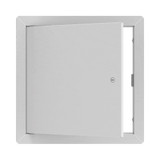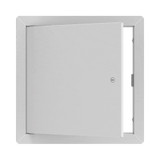Rebar Sizes in Canada: What Engineers and Estimators Need To Know
The smallest miscalculation in rebar sizing can snowball into costly delays, building code violations, and even structural issues. Misunderstanding rebar diameter or mislabeling rebar sizes can derail everything from design calculations to accurate bidding and purchasing.
Fortunately, a clear understanding of Canadian rebar standards and sizing designations helps construction professionals ensure structural integrity, avoid procurement missteps, and streamline budgeting.
This guide includes information about Canadian rebar, material take-offs, and ways to include access solutions in reinforced buildings.
Understanding Rebar Sizes and Standards in Canada
Rebar sizes in Canada follow the metric bar number system, which directly corresponds to the bar's nominal diameter in millimetres. This system differs from the imperial system used in the U.S., making it especially important for cross-border teams to stay aligned.
|
Metric Bar # |
Nominal Diameter (mm) |
|
#10 |
11.3 mm |
|
#15 |
16.0 mm |
|
#20 |
19.5 mm |
|
#25 |
25.2 mm |
|
#30 |
29.9 mm |
|
#35 |
35.7 mm |
For instance, a #10 Canadian rebar is not the same as a #3 U.S. bar—even if they're close in size. Inaccuracies in conversion or incorrect assumptions about equivalence can disrupt structural calculations, procurement, and code compliance.
Do you need custom solutions that align with your unique projects’ specs? Explore our custom access solutions for seamless integration with your structure.
Why Rebar Size Accuracy Matters for Engineers and Estimators
Rebar diameter isn't just a number—it's a structural variable that directly affects the load-bearing capacity, spacing, and reinforcement placement in concrete. For engineers, using the wrong size bar can lead to design errors that compromise safety and cause projects to fail inspection.
Spacing also plays a critical role. Concrete may not flow properly if the rebar is too large or spaced incorrectly, leading to weak spots or cracking. Moreover, rebar weight per metre varies by diameter, influencing foundational support calculations.
Accurate Canadian rebar sizing also ensures that structural elements like access doors and panels are installed precisely, without clashes or misalignment. Whether it's a floor door in a concrete slab or an equipment vault access point, proper rebar planning is essential for clean execution.
Material Take-Offs and Cost Estimation Made Easier
Knowing the exact rebar sizes and their corresponding weights per metre is a must. The weight of #20 rebar differ significantly from #30, directly impacting material costs and structural requirements.
Errors in estimating lead to two common issues: over-ordering, which inflates the budget, and under-ordering, which causes costly project delays. Estimation software and take-off tools rely on accurate input data—if the diameter is wrong, everything downstream suffers.
When sizes are clearly understood and standardized, it becomes easier to coordinate with procurement teams and suppliers. That reduces the risk of miscommunication and ensures that the right quantity and grade of rebar arrives on site.
Want to save time and reduce errors in your next bid? Call us at 1 (888) 327-5471 or request a quote for reliable access solutions.
Canadian Compliance and Procurement Considerations
Canadian rebar must comply with CSA G30.18 standards, which define minimum yield strengths—commonly Grade 400W or 500W. These standards ensure consistency in mechanical properties and structural performance.
Because metric bar numbers align with Canadian Building Code requirements, procurement managers must understand these local conventions when sourcing materials. Importing or mistakenly specifying non-compliant rebar could lead to costly rework or failed inspections.
Having a firm grasp of Canadian sizing also helps procurement managers vet suppliers properly. Choosing vendors like Access Doors Canada—who understand regional codes and standards—helps reduce delays and supports compliance.
Standardization isn't just about materials; it's about reducing confusion, especially in complex projects with multiple stakeholders involved in ordering, delivery, and installation.
Complementing Rebar Planning With Access Solutions
Engineers and project managers must also consider access integration early in rebar and concrete planning. Reinforcement spacing, bar placement, and required clearances can significantly affect where and how floor doors and utility access points are installed.
For cast-in-place concrete applications, the ADC-BAC-FFD Floor Hatch Cast In Place 300lb/sqft offers reinforced strength, corrosion resistance, and safe, secure access—making it a smart choice for engineers integrating floor doors into rebar-dense environments.
Access Doors Canada offers tailored access solutions that align with concrete reinforcement layouts, ensuring frame installations and lid openings aren't compromised. Our products have functionality, security, and structural compatibility in mind. Don’t believe us? Read the reviews from thousands of construction professionals.
Planning access into your reinforced concrete designs? Discover top-selling access doors and floor door solutions today.
Conclusion
From engineering to procurement, rebar sizes in Canada play a critical role in structural integrity, accurate material take-offs, and code compliance. Missteps in sizing or designation can throw entire projects off course—causing budget overruns, delays, or even structural deficiencies.
By understanding Canadian rebar standards, diameters, and the implications of accurate estimation, your team can deliver safer, more efficient builds.
Partnering with suppliers offering construction insight and quality access solutions strengthens your project's foundation—literally and figuratively.
Ensure accuracy and efficiency in your Canadian construction projects. Contact us today for expert consultation on material specifications and access to reliable resources for structural steel and related construction materials.








